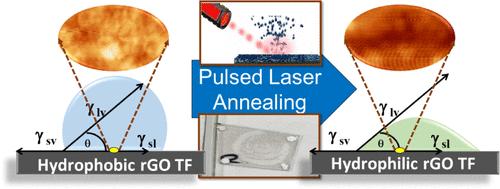脉冲激光沉积制备激光退火氧化石墨烯薄膜的疏水性调节
IF 3.9
2区 化学
Q2 CHEMISTRY, MULTIDISCIPLINARY
引用次数: 0
摘要
还原氧化石墨烯(rGO)因其优异的导电性、高比表面积和优异的机械强度而受到科学界的广泛关注。还原氧化石墨烯(rGO)的物理性质强烈依赖于其结构框架中不同官能团的存在,以及表面粗糙度。在这项研究中,采用纳秒Nd:YAG激光器进行激光退火,研究不同激光能量对脉冲激光沉积(PLD)技术生长的还原氧化石墨烯(rGO)样品润湿性和导电性的影响。采用10、20、30、38、48、55和250 mJ/cm2等不同的激光强度对氧化石墨烯薄膜进行退火处理。我们的研究结果揭示了润湿性的显著转变,将最初疏水的氧化石墨烯样品转变为亲水状态。亲水性氧化石墨烯(GO)或还原氧化石墨烯(rGO)表面由于其独特的特性组合,包括生物相容性、高表面积和丰富的含氧官能团,在生物医学应用中具有巨大的潜力。随着润湿性的变化,电导率也发生了变化。所提出的研究结果不仅有助于理解激光诱导的还原氧化石墨烯修饰,而且还强调了控制激光退火在定制石墨烯基材料表面性能方面的潜在应用,以实现各种技术进步。本文章由计算机程序翻译,如有差异,请以英文原文为准。

Tuning the Hydrophobicity of Laser-Annealed rGO Thin Films Synthesized by Pulsed Laser Deposition
Reduced graphene oxide (rGO) has captivated the scientific community due to its exceptional electrical conductivity, high specific surface area, and excellent mechanical strength. The physical properties of reduced graphene oxide (rGO) are strongly dependent on the presence of different functional groups in its structural framework, along with surface roughness. In this study, laser annealing was employed by a nanosecond Nd:YAG laser to investigate the impact of varying laser energies on the wettability and conductivity of reduced graphene oxide (rGO) samples grown by the pulsed laser deposition (PLD) technique. The rGO films were annealed with different laser fluences, such as 10, 20, 30, 38, 48, 55, and 250 mJ/cm2. Our results reveal a notable transition in wettability, transforming the initially hydrophobic rGO samples into a hydrophilic state. Hydrophilic graphene oxide (GO) or reduced graphene oxide (rGO) surfaces have significant potential for use in biomedical applications due to their unique combination of properties, including biocompatibility, high surface area, and abundant oxygen-containing functional groups. Along with wettability properties, conductivity changes were also observed. The presented findings not only contribute to the understanding of laser-induced modifications in rGO but also highlight the potential applications of controlled laser annealing in tailoring the surface properties of graphene-based materials for diverse technological advancements.
求助全文
通过发布文献求助,成功后即可免费获取论文全文。
去求助
来源期刊

Langmuir
化学-材料科学:综合
CiteScore
6.50
自引率
10.30%
发文量
1464
审稿时长
2.1 months
期刊介绍:
Langmuir is an interdisciplinary journal publishing articles in the following subject categories:
Colloids: surfactants and self-assembly, dispersions, emulsions, foams
Interfaces: adsorption, reactions, films, forces
Biological Interfaces: biocolloids, biomolecular and biomimetic materials
Materials: nano- and mesostructured materials, polymers, gels, liquid crystals
Electrochemistry: interfacial charge transfer, charge transport, electrocatalysis, electrokinetic phenomena, bioelectrochemistry
Devices and Applications: sensors, fluidics, patterning, catalysis, photonic crystals
However, when high-impact, original work is submitted that does not fit within the above categories, decisions to accept or decline such papers will be based on one criteria: What Would Irving Do?
Langmuir ranks #2 in citations out of 136 journals in the category of Physical Chemistry with 113,157 total citations. The journal received an Impact Factor of 4.384*.
This journal is also indexed in the categories of Materials Science (ranked #1) and Multidisciplinary Chemistry (ranked #5).
 求助内容:
求助内容: 应助结果提醒方式:
应助结果提醒方式:


